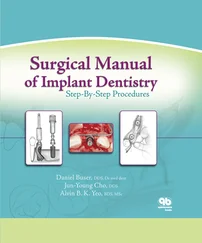Autogenous bone from bone mills.Particulate bone ground in a bone mill requires a bone block to be harvested from a donor site and involves an additional surgical intervention, causing morbidity. This procedure may provide more autograft volume than is available with bone dust from bone collectors. The milling process may reduce the number of viable cells.
Autogenous bone collected with a piezoelectric technique.There are not many data available on this harvesting technique. A recent preclinical study has shown that the dimensions of particulate autografts harvested with a piezoelectric device resemble those of bone chips collected with a bone scraper. 92
Autogenous bone from bone scrapers.This harvesting technique has been advocated over the past few years for minor bone regeneration procedures, such as extraction sockets and localized sinus augmentation procedures, or coverage of dehiscence-type defects, either alone or in combination with bone substitute materials. 95 – 97 With this technique, small particles of cortical bone are harvested by scraping the bone surface—a simple intraoral approach with which up to 5 cm 3 of bone can be obtained. 95 Osteocytes have been shown to survive the grafting procedure, but because of the cortical nature of the graft, very few osteoblasts and osteoblast precursors are expected to be present. The resistance against resorption is presumably low because of the high surface area–to-volume ratio. 97
Autografts are still considered the gold standard in osseous reconstructive surgery. 98 However, significant drawbacks related to the use of autografts have intensified the search for alternatives. First, there is the unpredictable resorption of up to 60% of corticocancellous block grafts. 99 If uniform resorption could be expected, it would be unproblematic to perform a standardized overcompensation of the augmented volume. Second, there is donor site morbidity. This is most pronounced in relation to the extraoral donor sites, 100 but it may also be significant in intraoral grafting procedures. 89 Finally, it can be a problem that autogenous bone is not available in unlimited quantities. With the main goal of reducing or even eliminating the shortcomings of autografts, the search for appropriate bone substitute materials has been going on for the past 50 years.
Allografts
Allografts consist of bone obtained from a donor and used in a member of the same species. Transplantation of bone from one individual to another has been performed in orthopedic surgery for more than 130 years. 101
Allografts are usually stored in bone banks, and they may be used as fresh frozen bone (FFB), freeze-dried bone allograft (FDBA), or demineralized freeze-dried bone allograft (DFDBA). FFB is rarely used in GBR procedures because of a high risk of immunologic rejection and disease transmission, whereas the freeze-drying of FDBA and DFDBA is reported to reduce the immunogenicity of the material, potentially improving the clinical outcome. Allografts are available as blocks or in particulate forms of both cortical and cancellous origin. 102 , 103
FDBA and DFDBA have been shown to be biocompatible and to contain osteoinductive molecules such as BMPs. 104 Demineralization of allografts is intended to expose the BMPs, additionally increasing the immediate osteoinductive potential. However, FDBA loses some of its mechanical stability during the demineralization process, and DFDBA should therefore be used in combination with a space-maintaining material if the bone defects are not self-contained. Different batches of DFDBA have been shown to contain very different concentrations of BMPs, 105 and the osteoinductivity can therefore be expected to vary correspondingly.
Histologic evidence from an experimental comparative study in the mandibles of minipigs showed that allografts decelerated new bone formation in comparison with autografts (positive control) and coagulum (negative control). 106 DFDBA showed osteoconductive properties, but osteoinductive potential could not be demonstrated. 106 Therefore, FFB, FDBA, and DFDBA indisputably contain osteoinductive molecules. However, it is still debatable whether the concentrations of these BMPs are sufficient to elicit clinically relevant osteoinductive potential and whether they are present in an active form.
Allografts are widely used in the United States, whereas local regulations in Europe restrict the collection of human bone. This has limited their popularity among clinicians. Compared with the limitations of autografts, donor site morbidity is not an issue, and allografts are available in abundant quantities. However, resorption is reported to take place, as is seen with autografts. 102
Xenografts
Xenografts, or xenogeneic bone substitutes, consist either of bone mineral derived from animals or bonelike minerals derived from calcifying corals or algae which have had the organic component removed to eliminate the risk of immunogenic reactions or transmission of diseases.
A few species of calcifying corals were found to have a calcium carbonate skeleton with a geometry similar to that of human cancellous bone, with interconnected macropores of 20 to 600 µm. The coralline calcium carbonate is transformed into hydroxyapatite (HA) by a hydrothermal exchange reaction with phosphorus. Experimental studies have demonstrated that the osteoconductive potential of coral-derived bone substitutes is less than that of other bone substitute materials. 106 , 107 Currently, coralline HA is seldom used for onlay grafts in GBR procedures because of a high rate of late complications. 108 When used as particulate, the granules tend to migrate, and the ones that are kept at the augmented site predominantly become encapsulated by fibrous tissue. The blocks, on the other hand, most often show bone formation throughout the augmented volume, but they are prone to develop late dehiscences. 109
There is also a group of marine algae that consist of a calcified exoskeleton made of calcium carbonate. The natural material is converted into fluorohydroxyapatite through an exchange reaction with ammonium phosphate at around 700°C. The morphologic structure is made up of pores arranged in parallel with a mean diameter of 10 µm and connected through microperforations. The pore configuration is thus not ideal for vascular ingrowth, but cellular invasion of the pores and bone deposition directly on the material surface have been documented. 110 , 111 Neovascularization is instead expected to take place in between the bone substitute particles. In contrast to coralline HAs, phycogenic fluorapatite undergoes slow resorption by enzymatic and cellular degradation, but at a lower rate than autografts. 110
Most xenografts originate from natural bone sources in animals. In particular, cancellous bovine bone has been used as a source for these bone substitute materials because of its close similarity to cancellous human bone. The organic component is removed by heat treatment, by a chemical extraction method, or by a combination of the two, in order to eliminate the risk of immunologic reactions and disease transmission. Since the first reports of bovine spongiform encephalopathy, there has been a particular focus on the ability of these extraction methods to completely eliminate all proteins from the bovine bone source. 112 , 113 However, despite the hypothetical risk of organic remnants in bovine bone substitutes, there have been no reports of disease transmission with the use of these biomaterials. In contrast, a few cases of transmission of HIV and hepatitis related to allogeneic materials have been reported. 114
Bovine-derived xenografts are generally biocompatible and osteoconductive, although the production methods have a strong impact on their biologic behavior. For instance, high-temperature treatment resulted in less bone formation and lower osteoconductivity. 107 , 111 , 115 This difference most likely reflects the production-related changes in surface characteristics. Temperatures exceeding 1000°C cause a sintering of the natural hydroxyapatite, with the apatite crystals growing and the intercrystalline spaces disappearing to a large extent. 116 This reduces the microroughness and micro- and nanoporosity of the bone substitute and increases the crystallinity.
Читать дальше












